|
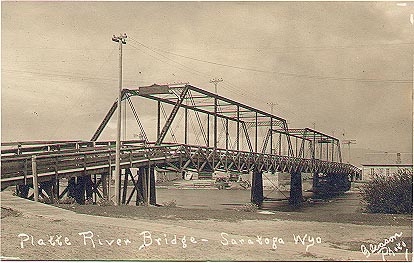
Saratoga Bridge, 1909. Photo by O. S. Gleason
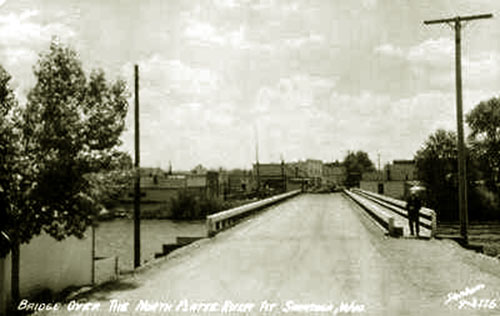
North Platte Bridge, looking west, 1947.
The majority of early settlers were stockgrowers. Julian Ralph in his
1993 Our Great West, a Study of the Present conditions and Future Possibilities of the New Commonweaths and
Capitals of the United States noted that in the 1880's there were twenty-five herds of cattle, fifteen
of which were owned by large stockgrowers. Everything in the valley was devoted to stockgrowing. Indeed,
Ralph noted that even potatoes was purchased. One of the largest ranches was the "Pick" outfit owned by the British
Sand Creek Land and Cattle Company [Limited] controlled by Member of Parliament Henry Seton-Karr, Conservative member for St. Helens.
Sir Henry is remembered for warning the House of Commons that Britain was becoming more and more dependent upon the importation
of food supplies. In the event of war, an enemy would attempt to cut off Britain from its overseas supplies and starve the nation.
A correspondent for the New York Times ridiculed the idea, calling Sir Henry as "one of those Englishmen * * * victims of mere statistics." The
New York Times correspondent contended that such an event was very unlikely. The Royal Navy would provide sufficient prevention. In two separate wars,
Sir Henry's unheeded warnings came true, and in two world wars, Germans did indeed attempt to cut the
British Isles off from food supplies.
Seton-Karr was knighted in
1902. He was a lawyer, author, and adventurer. He made 19 expeditions to Africa which he discovered
pre-historic flint mines in Somalialand and an emerald mine in Egypt. He made some 10 expeditions to India.
In 1883, Sir Henry acquired the ranch from Frank (1843-1892) and Boney Earnest (1852-1933) with Frank and Boney
staying on as managers while Sir Henry pursued other game. [Writer's note: various dates have been given for Boney's Birth. The date
given comes from the 1861 Canadian Census.] The ranch had along the Platte two units, one near Saratoga and the other about
40 miles down stream from Fort Steele. The Earnest brothers had previously guided
Sir Henry and other members of the British aristocracy on hunting trips in Wyoming. Sand Creek Land and
Cattle Company was duly capitalized at £100,000, cattle were acquired in Utah and shipped to Rawlins for trailing
to the ranch.
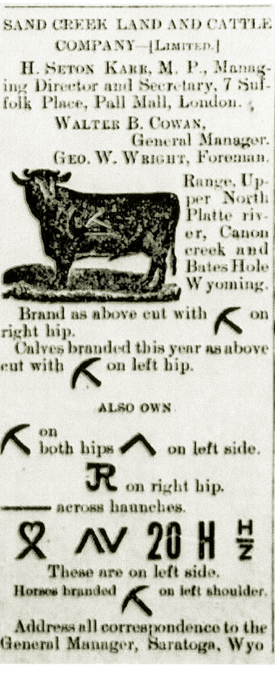
Left: Sand Creek Land and Cattle Company Brands; lower right:
Sir Henry Seton-Karr.
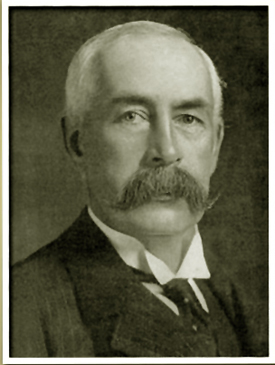
The Sand Creek Land and Cattle Company was capitalized at £100,000.
Sir Henry was also a director and an owner of the
XIT in Texas and Montana and expressed interest in cattle raising in Southern Rhodesia.
Boney Earnest later said that the Pick derived its name
from one of its brands in the form of a prospector's pick axe.
Sir Henry explained why he was induced into the cattle business:
IN 1883 the Western cattle business was in the hey¬day of its prosperity. English and
Scotch companies had been formed with substantial capitals to acquire, and they had acquired,
large herds of range cattle in Wyoming, Montana, Colorado, Kansas, Texas, and New Mexico.
Stock-owning in the wild and woolly West appealed alike to the English investor and to the
hard-headed Scotchmen of the North Country. Here was any quantity of fine grazing-land west
of the Missouri River belonging to Uncle Sam, that was to be had for the asking, so to speak.
The summer grazing for cattle through the foot-hills of the Rockies was simply magnificent.
Had it not sup¬ported buffalo in millions, and wapiti, antelope and deer in thousands,
for the past few centuries, or perhaps ever since time and creation began ?
Now that the buffalo were wiped out, and other kinds of graminivorous game were in the process
of being civilized off the face of these splendid natural grass ranges of a new western
continent, here was obviously the chance of a lifetime for remunerative stock-owning on a
large scale. Buy the cattle, register a brand, turn loose a crew of cowboys under
a good foreman or two, to brand calves in the spring and collect beef cattle in the fall,
with a highly-paid and responsible ranch-manager to handle the cash, do the writing,
and generally to run the show, and there you were.
It was an attractive commercial idea that worked out beautifully on paper, but somehow
or other, and generally speaking, did not turn out quite so re¬munerative in actual practice.
Sir Henry indicated that cattle simply "melted away" due to book counts, early and late snows and rustling. Often the
rustling was by a cattleman's own employees. He recalled one cowboy who he called "charley Smith," probably to protect the
guilty. "Smith would leave a calf out of the roundup and then later with a deft
turn of a branding iron, turned the calf into his own. Smith was fired by Sir Henry's foreman. This resulted in a shootout with the
foreman being killed. The cowboy was exonerated by the Grand Jury on the basis of self-defense, but, according to Sir Henry, the outfit believed
that the wrong man was killed. Smith was later killed in another encounter near Casper.
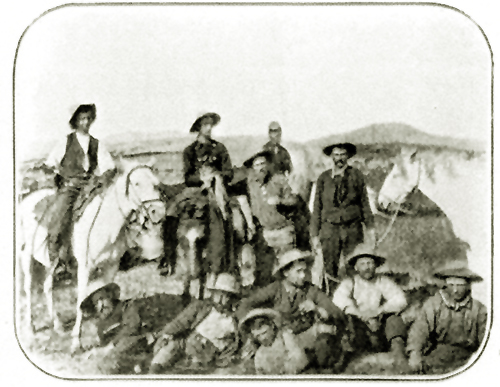
Pick Outfit, 1890's
In 1914, Sir Henry traveled to the United States and Canada hunting in British Columbia and visiting friends in Detroit.
There he booked his return to Liverpool on the
Canadian Pacific liner, Empress of Ireland, boarding in Quebec City. At the quay there was a premonition.
The Ship's cat, Emma who always traveled on the crossings repeatedly attempt to leave the ship, finally escaped to the
quay and refused to be enticed to reboard the ship. The great ship sailed without her, the cat watching from the roof of a shed.
Most, if not all the crew had signed on in Liverpool. About May 30, rumors spread about Liverpool that the ship had struck an
iceberg and sank. Crouds beseiged the Royal Liver Building seeking information. Officers from Cunard came from next door to see if
they could be of assistance. In a sense, the rumor was false, the ship had not struck an iceberg, it was struck amidships by a
Danish collier, ripping the ship's hull open. A passenger, D. A. Darling of Shanghai testified that Sir Henry emerged from his stateroom with a life
jacket on. The passenger did not have a life jacket. Sir Henry took his off and insisted that the Darling take Sir Henry's. Sir
Henry told the passenger that he would retrieve another from his stateroom and then disappeared into the room. The ship sank in fifteen minutes.
It was the worst civilian maritime disaster in Canadian history. The vast bulk of those who survived were third class passengers and members of the
crew. The worst loss of life was amongst the first class and second class passengers. The bodies that were recovered were placed in a
temporary morgue on the wharf. An honor guard from the HMS Essex stood guard. The New York Times, June 1, 1914, reported:
In the shed, which was 980 feet long, the coffins were placed upon three tables, each 100 feet
long. There was no sadder sight In the building than the table where rested the improvised coffins;
for many of them held the bodies of mothers and children locked in the last embrace just as
they had sunk to their death off Father Point early Friday morning.
Among the bodies in the shed was that of Sir Henry Seton-Karr, C.M.G. In the late 1980s Ontario diver John Reekie
recovered section of an antler from the wreck. It was believed to have been part of a trophy from
a hunting trip by Sir Henry.
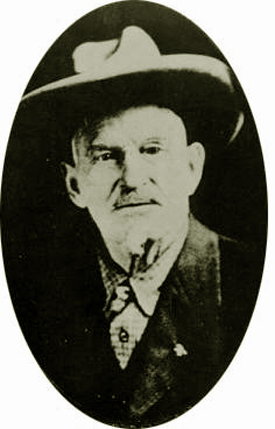 Boney Earnest, 1927 Boney Earnest, 1927
Frank and Boney Earnest were originally from Ontario and came to the United States in 1864. Sir Henry described
Boney as "in appearance a slendid specimen of frontier manhood, the ideal hero of western romance." (Seton-Karr, p. 185).
In 1864, Boney became a member of a party consructing Col. David A. Butterfield's
stage and wagon road from Atchison, Kansas, to Denver. The Indians were somewhat fierce. Boney later described them as
"thick as mosquitoes in a southern swamp. If we had not had an
escort of four hundred calavalry none of us would have come through alive and the stage road
would never have been built." Nevertheless, the first wagon got into Denver in June 1865. Boney drifted
west into what would later become Wyoming Territory. There he trapped and prospected. Along with Tom Sun and Frank
Harrington they filed claims near the ghost town of Sodium west of Casper. They were burned out by
Indians.
As to Frank Earnest, Sir Henry noted that "there was nothing
in the detail and necessary parahernalia of camp-life that he was not familiar with -- from chosing a camp
and shoing a horse to frying a venison steak and baking in a camp oven." Frank with Ed Bennett operated a
cable ferry across the
North Platte River. The cables were made of braided buffalo hide. In 1874, Boney, along with Tom Sun, became a scout for
Col. Anson Mills' expedition against the Indians. Boney Earnest became one of the three principal guides relied upon by
British hunters in the territory. The other two were Buffalo Bill and Texas Jack Omohundro. The three maintained a friendly rivalry. Sir
Henry recalled sharing drinks with Frank, Buffalo Bill, Texas Jack and Boney in a saloon at
Fort Steele:
We were assembled in a Fort Steele saloon, where Boney had been regaling the assembled
company with blood-curdling yarns of the hostile Indians, huge grizzlies, and impassable
cañóns, that he and his party had recently met with in the heart of the mountain ranges
on the Idaho border, a district then almost unknown. It was clearly implied from Boney's
narrative that unparalleled difficulties and dangers had there been successfully negotiated
by himself and his companions.
Buffalo Bill, to whom we had been formally introduced that afternoon, was present,
and for a time played the part of a silent and interested listener. Later in the evening,
after some further friendly intercourse and refreshment, Buffalo Bill unburdened his soul
on the subject of Boney's tales. 'Of the three biggest liars in America,'
he casually remarked, 'Texas Jack is one, and Boney, here, is the other two!'
It was thereupon unanimously agreed that Boney should set up the parting drinks. Seton-Karr, p. 187.
Boney along with Tom Sun became the hero of at least one "Penny Dreadful" type of story appearing in
Eastern weekly newspapers. In the story, Tom Sun, Boney Earnest, and Frank Harrington, were guiding "The Earl" hunting
elk near Elk Mountain and had thrilling adventures in fighting off wild Indians. See Brookfield, Madison County, N. Y. Courier, May 15, 1878.
The New York Daily Graphic, November 15, 1883, made fun of James Gordon Bennett, publisher of its rival
New York Tribune, contending that Bennett was planning a grand hunting party to be guided by
Buffalo Bill and Tom Sun, "for thirty years a guide and trapper," and "'Boney' Earnest, a wealthy ranchman of Rawlins, Wyoming."
The article claimed:
Tom Sun has the reputation of being one of the most interesting characters in the far West. He is the prince of
romancers, and it is from him that Buffalo Bill secured the material for his rude, wild, Western plays, as well as the dialect incorprated in them; while from
"Boney" Earnest Cody got his original education as a scout. .
The paper reported that at the conclusion of the expedition, considerable of the elk and deer secured by the party would be shipped to
Chicago and then to Louisville. The paper credited Bennett with introducing to the cowboys of the Southwest the bucking strap when he was gathering
bronchos for use in polo.
Among those actually guided by Tom Sun on hunting trips into the wilderness was Sir John Rae Reid (3rd Bart.) who later was
instrumental in the Anglo-American Cattle Company.
In addition to Sir Henry Seton-Karr, Boney and Frank Earnest guided Sir George Trevelyan, Lord Fell, and Lord Napier.
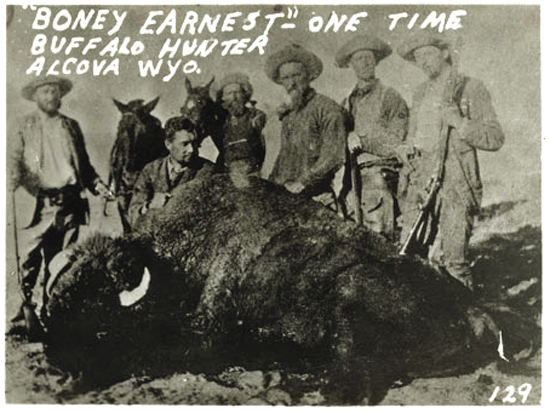
Bison slain by Boney Earnest and British hunting party near Powder River Station, 1879.
Left to Right: Lord Trevelyan, Lord Fell, Frank Earnest, Boney Earnest, Charles cummings, Lord Napier.
Charles "Southpaw" Cummings (1856-1934) was an employee of Frank Earnest and was also a trapper and freighter. Powder River Station was located in
present-day Johnson County. Boney later indicated that where only a few
years before bison were seen by the thousands, by 1879, the bison had all but disappeared. On the particular expedition, they saw
only three. Frank died in 1892 from a heart attack whilst fishing. Boney established the
Pathfinder Ranch along the North Platte near present day Alcova. He died in 1933.
Another major spread was Hugus, Millison & Beall, Stock Growers, owned by W. B. Hugus,
J. H. Mullison and J. W. Beall. The name lives on in Saratoga in the name of a ditch. The
outfit ran forty-five brands which were an accumulation of brands previously owned individually by the
three partners.
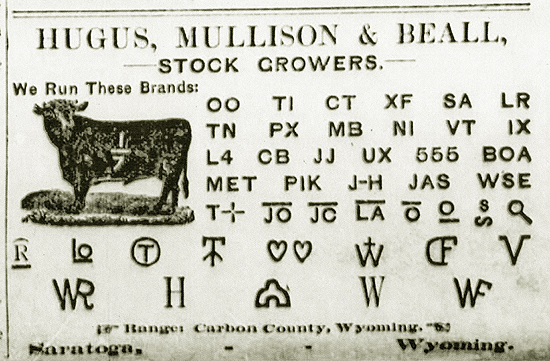
Huggus, Mullison & Beall Brands.
In 1892 and experimental farm was established. The superintendent reported in his annual report:
C. W. Burdick and J. H. Mullison, of Saratoga, and C. L. Yagner, of Carbon, located the Farm,
which was organized with J. H. Mullison in charge till June, when John D. Parker was
appointed Superintendent. The ground below the ditch had been cleared of sage brush and
prepared for planting. Various farm and garden crops and trees were planted. The Farm is
fenced with five barbed wires stapled on cedar posts, 16 1/2 feet apart, with strong pole gates.
The two-story frame barn is 24x30 feet, well built and painted and contains seed and store
rooms and stabling for four horses. The root cellar, 16x16 feet is 8 feet high, and being
roofed deeply with earth is frost proof.
The Farm owns a stirring plow, grain drill, harrow, cultivators, garden drill, mowing machine,
hay rake, fanning mill, potato drill, wheelbarrow, platform scales, ditching tools and
carpenter's tools. There is on hand a number of logs and about 4.000 feet of rough pine
lumber to be used in building bridges across the main irrigation ditches, and in making flumes
and headgates.
As late as the first of May, the Farm was covered with thrifty matted sage brush, was unfenced.
and had never been irrigated. Six weeks later the crops were luxuriant. Notwithstanding the
much shortened growing season, 55 varieties out of the 60 planted came to maturity. The
accompanying tables gives the result of some of the most useful of these experiments.
Potatoes on new ground yielded 120.5 bushels per acre, The average yield of the United States
in 1891 was 93.9 bushels, the largest yield in ten years. The buckwheat filled and ripened
well. The sugar beets yielded 17.4 tons per acre, and analyzed 16.1 per cent of sugar. The
yield of sugar would have been greater had they not grown so near the irrigation ditch.
A part of the alfalfa was mowed when about ten inches high, to test the effect upon stooling
and stand.
The summer's work has proved that potatoes, oats, wheat, barley, rye, flax, sugar beets,
turnips, rutabagas, lettuce, peas, carrots, alfalfa, millet, buckwheat and early onions can
be raised successfully in the North Platte Valley, wherever water can be put on the soil.
Wheat withstands drouth better than oats. Cabbage and celery require more water than corn or
beets. Potatoes irrigated three times will generally produce a larger crop, though poorer
quality, than those irrigated twice. One irrigation will often make a good crop of potatoes.
Flooding is not so good for many crops as seepage irrigation, but is more quickly done.
Alfalfa makes better hay when harvested in cloudy weather. Millet and corn are injured by early
frost, but flax and sugar beets withstand heavy frosts.
Gradually, the valley was given over to smaller ranches who fed
alfalfa in the winter and growing of crops. Thus, the valley changed from a few large herds
to a larger number of smaller farmers and ranchers with small herds. By 1892, the town was booming. In that
year Chatterton, Burdick and Whittlesey constructed a two story brick building with a public hall and offices on the
second floor, Couzens & Co. added a second floor to their building. The building was too small for their business and it
was sold to Saratoga Lodge No. 14 A.F. & A. M. who used the second floor for their lodge. The town boasted of a
public library with 1000 books ,the two-story Windsor livery stable, and a flouring mill capable of milling 35 barrels of flour a day, The
following year Ed Worthy's stage line provided three times a week stage service to the railroad at
Fort Steele with return the following day. The same year the Elk Head Saloon secured the services of an "orchestra" which
provided free concerts one day a week. By 1894, Wilxox and Landes' Fort Steele and Saratoga Rapid Transit Co. provided daily
stage service to Fort Steele and by the following year a telegraph line to Fort Steele was open.
Next Page: Saratoga Continued, Stage Lines, Gus Jensen
|